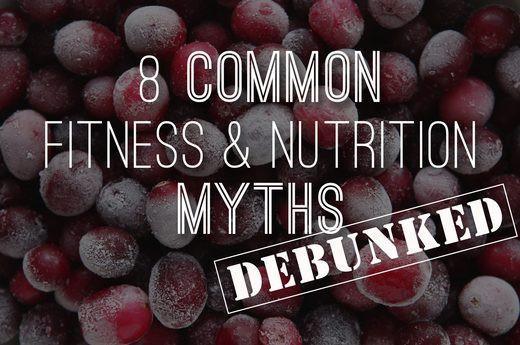
8 Fitness Myths Debunked
Myth 1: No pain, no gain
No doubt you have heard this saying before when referring to exercise. However if you experience pain such as joint pain, bone pain, muscle strains, and ligament or tendon strains, during or after exercise, it is your body’s way of telling you to back off. If you ignore the signals, there is a big risk of injuring yourself.
Exercise can cause muscle soreness and fatigue and this is normal. Most muscle soreness is caused by Delayed Onset Muscle Soreness (DOMS) which can be expected 12-48 hours after a workout, however this soreness is not always an indicator of progress. You don’t need to be sore after each workout to make progress.
However to make progress in your fitness you do need to go beyond your perceived limits and your comfort zone. You need to try new things and work hard. This may not cause you physical pain but it can cause mental pain. But don’t stress. The end result will be well worth it and you’ll feel mentally stronger because of it!
Myth 2: The more you do, the better your results
Many people exercise too frequently in the hope of getting better results. However too much of a good thing can be detrimental to your training. If you train too frequently, for too long without adequate rest you will suffer from over training. Over training can cause a decrease in your performance and you can actually lose fitness and strength from training too much.
Some signs of overtraining include:
- Persistent DOMS
- Elevated morning pulse
- Feeling unmotivated and lacking energy
- Increased susceptibility to illness and infection
Remember your body needs rest in order to get the best results.
Myth 3: Fat burning is best achieved with steady state aerobic exercise
Steady state aerobic exercise (low to moderate intensity) has historically been recommended as a fat loss method because as exercise intensity increases, the percentage of fat used for energy decreases, and the percentage of carbohydrates used increases. Examples of steady state aerobic exercise includes long walks or jogging. However this type of exercise burns fewer calories whilst performing the exercise and very little, if any, in the hours after you finish, then say, if you were doing interval training.
Myth 4: You can spot reduce fat
Spot reduction refers to the reduction of fat around a specific part of the body. An example of this common myth in action is people performing endless amount of abdominal exercises in the hope of getting a flatter tummy. However building muscle strength in the abdominal area does not reduce fat in that area.
No matter where you store fat, there is no evidence that you can fatten up or slim down in specific spots at will. Unfortunately our genes have determined how our fat stores change with weight loss.
Myth 5: If you stop exercising your muscles will turn to fat
It is not physically possible for muscle to turn to fat as they are two different muscle tissues. However, many people hold this view because when people stop exercising muscle mass generally decreases. This reduction in muscle mass means a reduction in metabolism, which can lead to people gaining weight and storing more fat.
So by stopping exercise you will generally lose muscle and gain fat, which can give the false impression of muscle turning to fat.
Myth 6: Drink sports drinks during and after workouts to stay hydrated
Staying hydrated before, during and after a workout is important, but if you are exercising for less than 60 minutes there is little evidence to suggest having a sports drink will provide additional benefits to having water. Your body won’t be working hard enough to run out of electrolytes or glucose (which is the benefit of sports drinks over water) and therefore you are only adding unnecessary calories to your diet.
A sports drink however is beneficial when engaged in intense workouts over 60 minutes, or in endurance events such as marathons and long distance cycling. So if you are just hitting the gym for a spin class or a weights workout, you’re better off saving your money and sticking to water to keep yourself hydrated.
Myth 7: Stretch before you workout to prevent injury
Stretching as a warm-up before exercise is common place, and has been for a long time. However research has found that there isn’t any correlation between stretching and injury prevention. As a warm-up increasing blood flow to the muscles through some light cardio and dynamic movements is actually more conducive to injury prevention.
Myth 8: The best time to exercise is first thing in the morning
Some people are just naturally morning people, like myself and prefer to exercise in the morning. Other people are slower to get moving in the morning and prefer to exercise later in the day. The good news is that there is no optimal time to exercise for everyone. The best time of the day to exercise is the time you can commit to. Pick a time that suits you and make it part of your daily/weekly schedule.
Website: thrivept.net/, Facebook , Instagram



 Selling fast. Order before they're gone!
Selling fast. Order before they're gone!